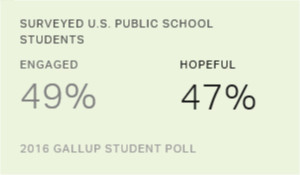Story Highlights
- Higher-education institution mission statements are too similar
- Few institutions refer to their tangible outcomes
- Leaders must establish unique values based on clear outcomes
"We prepare the leaders of tomorrow."
"We nurture lifelong learners."
"We aim to have a global impact, while serving our local community."
If mission statements such as these sound familiar to leaders in higher education, it's no surprise. These statements could easily reflect the mission and purpose of almost every higher education institution -- to the point where it's tough to distinguish one school from the next.
In a recent study, Gallup found that the mission, purpose or vision statements of more than 50 higher education institutions share striking similarities, regardless of institution size, public or private status, land-grant status or religious affiliation, or for-profit or not-for-profit status.
Now, these mission statements may accurately represent the broad views and aspirations of education leaders and their institutions. And they probably differentiate the institutions from financial service and retail companies.
But the statements offer little guidance to current and future students who are trying to select one institution over another. Given the growing expansion of higher education options -- from online degrees to private-sector training programs -- education leaders can no longer rely on factors such as location, tradition or student/faculty ratio to stand out from other institutions.
Traditional college ranking systems also seem to recognize the same "top schools" year after year, with little change in the rankings. If a novel education option were to come along that delivered a superior educational experience, one wonders whether traditional ranking lists would even recognize it.
What Are the Tangible Outcomes?
What's striking is how few institutions refer to tangible outcomes -- such as the percentage of graduates who actually go on to be "leaders of tomorrow" -- to demonstrate how effectively the institution lives its own mission or is able to provide benchmarks for comparison against other institutions. Statements often refer to creating or nurturing lifelong learners as part of the mission, purpose or values of the institutions we studied, for example, but there is little evidence to back up that claim. Gallup analysis shows that graduates with a bachelor's degree are no more likely to report that they "learn or do something interesting every day" than those with less than a bachelor's degree.
Instead, universities frequently cite acceptance ratios, four-year graduation rates, average student debt and starting salary without any mention of outcomes related to the institution's mission. Findings from the Gallup-Purdue Index, now the Gallup Alumni Survey -- a comprehensive, nationally representative study of more than 30,000 college graduates -- tells us that only 11% of all college graduates are thriving in all five elements of well-being as measured by the Gallup-Healthways Well-Being Index, which includes purpose, social, financial, community and physical well-being. This clearly leaves a lot of room for improving on outcomes.
Establishing a Unique Identity That Is Focused on Outcomes
The lack of enduring and unique identities in higher education offers an opportunity for education leaders, as it indicates there are a host of undifferentiated brands ripe for disruption. By strategically rethinking the three components of the institution's identity -- purpose, brand and culture -- with the intention of establishing unique and outcome-focused values, leaders can create clear and compelling statements that distinguish their institution from all others. Here are some initial steps education leaders can take to create such statements and identities:
- Establish a clear and differentiated purpose. An organization's purpose should be more than a simple mission statement -- it should boldly affirm the institution's reason for existing from a historical, ethical, emotional and practical perspective. The institution's purpose should answer two questions: "Why do we exist?" and, "What value do we provide to the world?"
The purpose statement not only provides the organization with necessary direction, but it also declares why the institution is a student's ideal choice in higher education. Given that the mission and purpose statements of most higher education institutions are similar, if not identical, forward-thinking education leaders can carefully craft a differentiated and compelling purpose message. - Align the brand. Among universities and colleges, the lack of differentiation in guiding principles cascades down to the brand. An institution's brand is how it is known to others -- from current and future students to the communities, alumni networks and current and prospective employers the organization serves. To help an institution stand out, a brand should communicate much more than location, institution type, historical tradition, school colors and mascot -- it should tell the outside world what the institution is and what it will deliver.
By crafting a brand promise that distinctly states what the institution offers, why it's different and why it's worthy of students' consideration, education leaders can align brand messages with their purpose and begin to set the institution apart with a unique educational experience. Babson College, for example, has become synonymous with "entrepreneurship." It provides classic elements of a liberal arts college, but with a specific and unique focus on entrepreneurship as part of its branding and of the overall educational experience it provides for students. - Support identity with an engaged culture. The final component of an organization's identity is its culture. For education institutions, culture encompasses more than the work culture or how things are accomplished every day -- it also includes student experiences. What does it feel like to be on campus every day as a student, to learn in class and to interact with other students and with professors? Education leaders should thoughtfully and honestly consider not only whether the institution has a unique culture, but also how well that culture supports the institution's purpose and brand. Do students' daily experiences align with and reinforce the institution's purpose and brand?
The process of forging a strong organizational identity only starts with establishing and committing to a clear and differentiated purpose, brand and culture. After setting the direction, leaders should reinforce the organization's identity each day in the way they communicate, how they connect employees and students with the organization's values, how they select and develop their faculty and staff, how they structure the organization and how they measure and manage the performance of instructors, staff and the institution as a whole.
In too many cases, these leadership activities are loosely influenced by the organization's purpose, brand and culture. But in an institution with a strong identity, leaders intentionally design each of these tasks to reflect the organization's stated purpose and the unique educational experience it promises. When leaders ensure clear communication, alignment of activities and consistent execution, the institution's identity can be translated into a reality.
Institutions of higher education have long relied on marketing and branding to improve their admissions yield and alumni donations. Yet few have distinguished themselves as unique amid the thousands of existing institutions and among the growing options for students. Time-worn and generic marketing strategies are dead. It's time for institutions to get serious about defining their purpose, identity and culture -- and aligning these with their outcomes.


